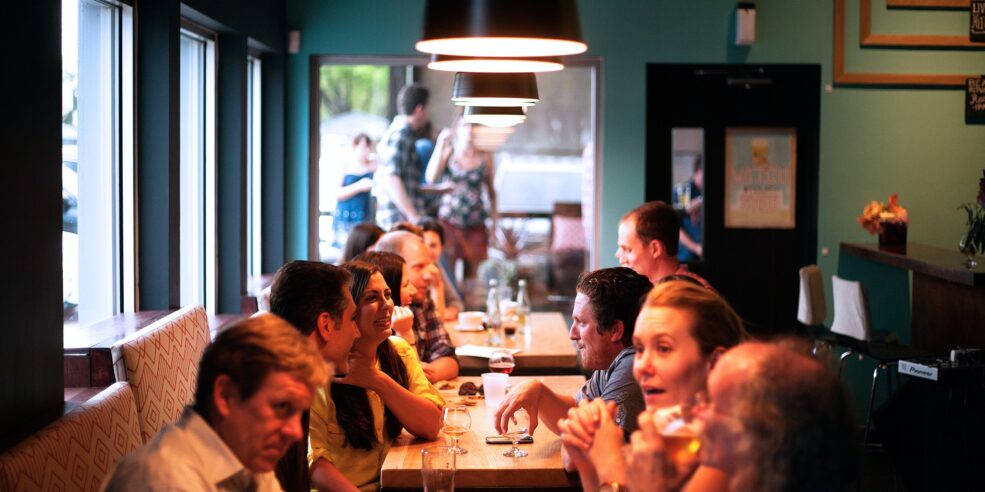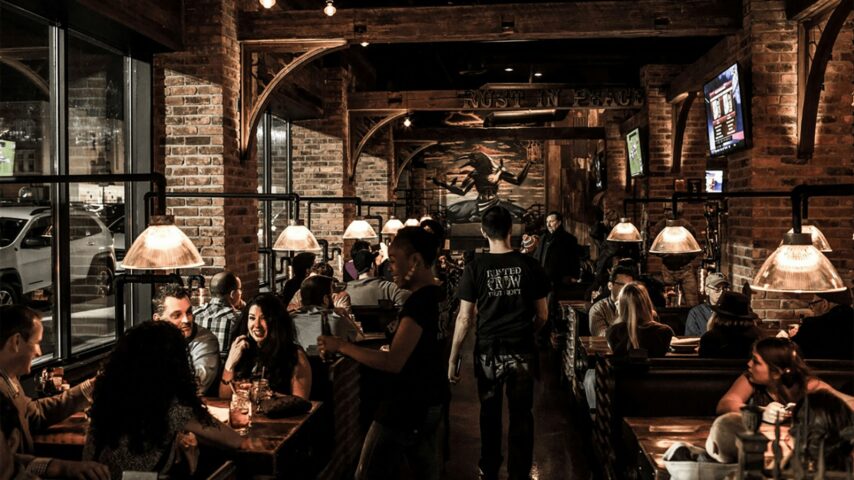Inflation is prevalent in everyone’s lives at the moment, but it’s having an especially large impact on the hospitality industry.
Why? Well, it’s because food and drink inflation is the highest of all categories at 12.2% in September 2023. This has caused a significant increase in costs for restaurants, which already operate on tight profit margins.
In this article, we will discuss the rising costs in the restaurant industry, how inflation has affected dining habits, and what restaurants can do to combat decreasing profit margins.
“Restaurants are affected by food, labour & energy inflation. This means they need to increase their prices to protect margins which in turn may reduce demand. It’s a tough balance to keep.” – Christian Mouysset, Tenzo’s Co-Founder
Rising Costs in the Restaurant Industry
Inflation’s impact on restaurants is clear when you consider all the rising costs and shrinking margins. As inflation affects customer habits, restaurants are facing challenges in cost control and profitability as well as generating revenue. The increasing costs in the restaurant industry are putting pressure on businesses to find ways to maintain their margins.
Rising labour costs and staffing challenges have also contributed to the shrinking margins in the restaurant industry. Minimum wage increases and the rising cost of living have led to higher labour costs for restaurants. This has created a labour shortage for some businesses that cannot afford to compete with larger establishments, further decreasing the labour pool in the hospitality industry. Labour costs have been increasing by 10% monthly since April 2021, adding to the financial strain on restaurants.
Increasing Cost of Goods Sold
The cost of goods sold in restaurants has been significantly affected by inflation. Food and drink inflation is at over 10%, as of September 2023, leading to higher expenses for restaurants.
In the past, the cost of goods as a percentage of revenue was much lower compared to now. This disruption to the normal COGS means restaurants are now spending a larger portion of their revenue on purchasing the ingredients and supplies needed to run their business. As a result, profit margins are shrinking and it is becoming more challenging for restaurants to maintain profitability.
Rising Labour Costs and Staffing Challenges
Rising labour costs and staffing challenges have become major challenges for restaurants.
Not only has the London Living Wage increasing put a strain on labour costs, making it more difficult for restaurants to maintain their profit margins, but the global rising cost of living has meant that labour cost demands are increasing, putting further pressure on restaurants.
Labour costs have been increasing since April 2021, adding to the financial burden for restaurants. With higher wages, restaurants are finding it harder to afford the necessary staff to run their operations smoothly. This has led to understaffing issues, which can impact the quality of service and overall customer experience. Restaurants having to allocate more of their budget towards labour costs leaves less room for other expenses such as food and equipment.
The labour shortage in the hospitality industry has made it even more challenging for restaurants to find and retain qualified staff. With limited options and competition from larger establishments, smaller restaurants are struggling to attract and keep employees. This can lead to increased turnover rates and a lack of consistency in staffing, which can negatively impact the overall efficiency and productivity of the restaurant.
As a result, restaurants are having to come up with creative solutions to address the staffing challenges, such as offering higher wages or implementing flexible scheduling options.

How Inflation Has Affected Dining Habits
Inflation has also had an impact on dining habits, with customers adjusting their spending patterns. Speculation suggests that while the average transaction value (ATV) has increased, the number of transactions has decreased.
How much are customers spending?
Over the last year, the average transaction value (ATV) for restaurants in the South East of England increased by 5.7% compared to the previous year. This likely means that, on average, customers are spending more money when they go out to eat.
The increase in ATV could be due to rising restaurant prices. As inflation pushes up the cost of ingredients and other expenses for restaurants, they pass on these costs to the customers by raising their prices. This would result in customers spending more money per transaction, but, due to the cost of goods sold increasing, businesses aren’t getting anymore out of each transaction. With tightening margins, it’s likely they’re getting less.
Despite the rising costs, customers may still be willing to pay higher prices for their favourite meals or for the convenience of eating out. This willingness to spend more could be driven by factors such as a desire for social experiences, and because people may be going out less regularly.

Changes in dining-out habits
We have also looked into changes in the dining-out habits of diners in the South-East of England over the last year. Many believed that the number of transactions would decrease, with increasing ATV. However, the number of transactions has increased by 2% between September 2022 and September 2023.
This unexpected increase in the number of transactions, alongside rising costs, may mean that diners are choosing to eat in more affordable restaurants. Customers may be spreading their disposable income out and shifting from fine-dining restaurants to casual, or fast-casual, restaurants.
This could also mean that when customers are eating out they are splitting the bill more. The figure for the number of transactions does not tell us how this aligns with the number of covers.

What can restaurants do to combat decreasing profit margins?
To combat decreasing profit margins caused by inflation, restaurants can take several steps to boost their profitability. This can involve all aspects of the business; from menu engineering to labour efficiency, and improving the guests’ experience.
Personalising the guest experience is another strategy that restaurants can employ to improve profit margins. By creating a loyal customer base, restaurants can ensure repeat business and customer satisfaction. Personalising experiences using reservation and CRM systems to build a database on customers, such as their birthdays and favourite wines, allows restaurants to send personalised deals and offers to keep customers coming back.
Menu Engineering
Menu Engineering is an essential strategy for restaurants to use to combat decreasing profit margins. All aspects of menu engineering can lead to improved sales and decreasing costs: boosting profit margins, but we’re going to focus on pricing and menu size here.
Pricing can be a huge challenge for restaurants, but it’s essential that pricing is altered to align with inflation, taking into account the rising costs of ingredients and other expenses. However, it is important to strike a balance and not set prices too high, as this can push customers away and towards competitors. Small increases of 50p or £1 on best-selling dishes can have a huge overall impact on revenue.
Review the price of all menu items, both food and drink and see how the cost of each item compares to the sale price. It’s also important to understand each menu item’s impact on overall revenue. For example, increasing the price of a low-selling menu item by 5% might have a minimal impact on margins and revenue, so might not be worth doing.
Another menu engineering strategy to boost performance is reducing the menu to create a more efficient kitchen. By streamlining the menu and focusing on the most popular and profitable items, restaurants can reduce labour and inventory costs. This allows for better control over expenses and helps to maintain profit margins.
Reducing the menu can also lead to faster service and improved customer satisfaction. With a smaller menu, the kitchen staff can focus on perfecting the preparation of a limited number of dishes, resulting in quicker turnaround times and a more efficient operation overall. This can help to attract and retain customers, even in the face of rising costs and shrinking margins.
Labour Efficiency
Labour efficiency is another business area that restaurants should focus on to improve performance and profit margins. By using data to monitor labour productivity, restaurants can identify areas where optimisation is necessary and make adjustments accordingly.
Another way to improve labour efficiency is to get the most out of your current labour costs. This means not using time and resources to make something that can be better, and cheaper, sourced elsewhere. By outsourcing certain tasks or using pre-made ingredients, you can save time and money while still delivering high-quality food to your customers.
Improving labour productivity can also come from understanding best practices and learning from top employees. By observing and learning from your most efficient and skilled employees, you can implement their techniques and strategies across your entire staff. This can lead to faster and more efficient service, ultimately boosting your margins through increased sales.
Personalising Guest Experience
Personalising the guest experience is essential in the restaurant industry. By creating a loyal customer base, you can ensure repeat business and increase revenue – returning customers provide 67% more revenue in their lifetime than the equivalent of new customers.
To achieve this, it is important to give customers an experience that they believe is worth the money. This means going above and beyond to exceed their expectations and provide exceptional service. These changes in going-out habits are more about finding a balance between cost and quality, with customers seeking value for their money.
One way to personalise the guest experience is by using a CRM system to build a database of your customers. This allows you to gather information such as birthdays, favourite wines, and dietary preferences. With this knowledge, you can personalise deals and offers sent to them, making customers feel special and encouraging them to keep coming back.
Conclusion
In conclusion, the impact of inflation on the restaurant industry has led to rising costs and shrinking profit margins. With cost of goods sold and labour costs increasing, it makes it harder for restaurants to maintain their performance whilst being affordable to their customers.
To combat these challenges, restaurants can focus on menu engineering, optimising labour efficiency, and personalising the guest experience. It’s crucial to ensure that costumers feel they are getting value for their money, if you’re having to increase prices personalise experiences and make customers feel more special, and their experience more memorable.
Overall, navigating the effects of inflation requires strategic decision-making and adaptability in order to maintain profitability in the restaurant industry. Using restaurant data is vital in monitoring the success of business changes and tracking performance.





